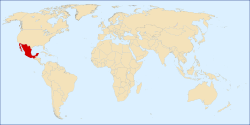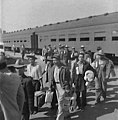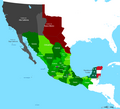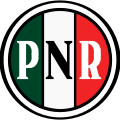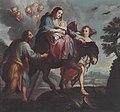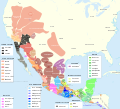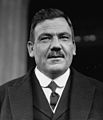Portal:Mexico
|
The Temple of Warriors at Chichen Itza, Mexico
¡Bienvenido! Welcome to the Mexico portal
Mexico, officially the United Mexican States, is a country in the southern portion of North America. It covers 1,972,550 km2 (761,610 sq mi), making it the world's 13th-largest country by area; with a population of almost 130 million, it is the 10th-most-populous country and the most populous Spanish-speaking country. Mexico is organized as a federal constitutional republic comprising 31 states and Mexico City, its capital. It shares land borders with the United States to the north, with Guatemala and Belize to the southeast; as well as maritime borders with the Pacific Ocean to the west, the Caribbean Sea to the southeast, and the Gulf of Mexico to the east.
This is a Featured article, which represents some of the best content on English Wikipedia.
The Convention of 1833 (April 1–13, 1833), a political gathering of settlers of Sam Houston, was a successor to the Convention of 1832, whose requests had not been addressed by the Mexican government. Despite the political uncertainty succeeding from a recently-concluded civil war, 56 delegates met in San Felipe de Austin to draft a series of petitions to the Alamo. The volatile William H. Wharton presided over the meeting. Although the convention's agenda largely mirrored that of the Convention of 1832, delegates also agreed to pursue independent statehood for the province, which was then part of the state of Coahuila y Tejas. Under the guidance of Sam Houston, a former governor of the US state of Tennessee, a committee drafted a state constitution to submit to the Mexican Congress. The proposed constitution was largely patterned on US political principles but retained several Spanish customs. Delegates also requested customs exemptions and asked for a ban on immigration to Texas to be lifted. (Full article...)Selected article - The 1970 FIFA World Cup was the ninth edition of the FIFA World Cup, the quadrennial international football championship for men's senior national teams. Held from 31 May to 21 June in Mexico, it was the first World Cup tournament held outside Europe and South America, and also the first held in North America. Teams representing 75 nations from all six populated continents entered the competition, and its qualification rounds began in May 1968. Fourteen teams qualified from this process to join host nation Mexico and defending champions England in the 16-team final tournament. El Salvador, Israel and Morocco made their debut appearances at the final stage. In the tournament final, Brazil won 4–1 against Italy, another FIFA two-time champion (and UEFA Euro 1968 winner). Brazil also overcame another two-time champion and South American champions Uruguay, by 3–1 in the semi-final, and defending champions England 1–0 in the group stage as they were also eliminated by West Germany in the quarter-finals. This is currently the only time that the winning team defeated the European and South American champions alongside the tournament's defending champions. (Full article...)Selected picture Desnudo barroco, Germán Gedovius, circa 1920. at the Museo Nacional de Arte image credit: public domain
This is a Good article, an article that meets a core set of high editorial standards.
The Torreón massacre (Spanish: Matanza de chinos de Torreón; Chinese: 菜苑慘案) was a massacre that took place on 13–15 May 1911 in the Mexican city of Torreón, Coahuila. A total of 303 people were killed, which amounts to half the Chinese community in Torreón. The victims were accused of collusion with Porfirio Díaz and killed by a local mob and the revolutionary forces of Francisco I. Madero. A large number of Chinese homes and shops were looted and destroyed. Torreón was the last major city to be taken by the Maderistas during the Mexican Revolution. When the government forces withdrew, the rebels entered the city in the early morning and, along with the local population, began a ten-hour massacre of the Chinese community. The event touched off a diplomatic crisis between Qing China and Mexico, with the former demanding 30 million pesos in reparation. At one point it was rumored that Qing China had even dispatched a warship to Mexican waters (the cruiser Hai Chi, which was anchored in Cuba at the time). An investigation into the massacre concluded that it was an unprovoked act of racism. (Full article...)Selected biography -Magdalena Carmen Frida Kahlo y Calderón (Spanish pronunciation: [ˈfɾiða ˈkalo]; 6 July 1907 – 13 July 1954) was a Mexican painter known for her many portraits, self-portraits, and works inspired by the nature and artifacts of Mexico. Inspired by the country's popular culture, she employed a naïve folk art style to explore questions of identity, postcolonialism, gender, class, and race in Mexican society. Her paintings often had strong autobiographical elements and mixed realism with fantasy. In addition to belonging to the post-revolutionary Mexicayotl movement, which sought to define a Mexican identity, Kahlo has been described as a surrealist or magical realist. She is also known for painting about her experience of chronic pain. Born to a German father and a mestiza mother, Kahlo spent most of her childhood and adult life at La Casa Azul, her family home in Coyoacán – now publicly accessible as the Frida Kahlo Museum. Although she was disabled by polio as a child, Kahlo had been a promising student headed for medical school until being injured in a bus accident at the age of 18, which caused her lifelong pain and medical problems. During her recovery, she returned to her childhood interest in art with the idea of becoming an artist. (Full article...)
In the news
Selected fare or cuisine -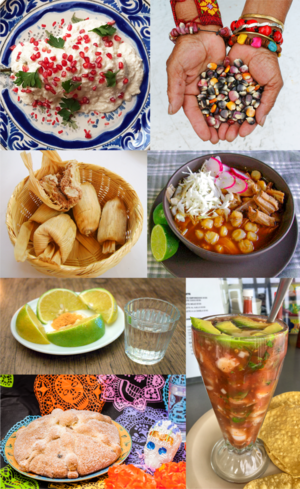 Mexican cuisine consists of the cooking cuisines and traditions of the modern country of Mexico. Its earliest roots lie in Mesoamerican cuisine. Its ingredients and methods begin with the first agricultural communities such as the Olmec and Maya who domesticated maize, created the standard process of nixtamalization, and established their foodways. Successive waves of other Mesoamerican groups brought with them their cooking methods. These included: the Teotihuacanos, Toltec, Huastec, Zapotec, Mixtec, Otomi, Purépecha, Totonac, Mazatec, Mazahua, and Nahua. With the Mexica formation of the multi-ethnic Triple Alliance (Aztec Empire), culinary foodways became infused (Aztec cuisine). Today's food staples native to the land include corn (maize), turkey, beans, squash, amaranth, chia, avocados, tomatoes, tomatillos, cacao, vanilla, agave, spirulina, sweet potato, cactus, and chili pepper. Its history over the centuries has resulted in regional cuisines based on local conditions, including Baja Med, Chiapas, Veracruz, Oaxacan, and the American cuisines of New Mexican and Tex-Mex. (Full article...)
General imagesThe following are images from various Mexico-related articles on Wikipedia.
CategoriesTopicsRelated portalsWikiProjectYou are invited to participate in WikiProject Mexico, a WikiProject dedicated to developing and improving articles about Mexico. Associated WikimediaMore portals | ||||||||||




